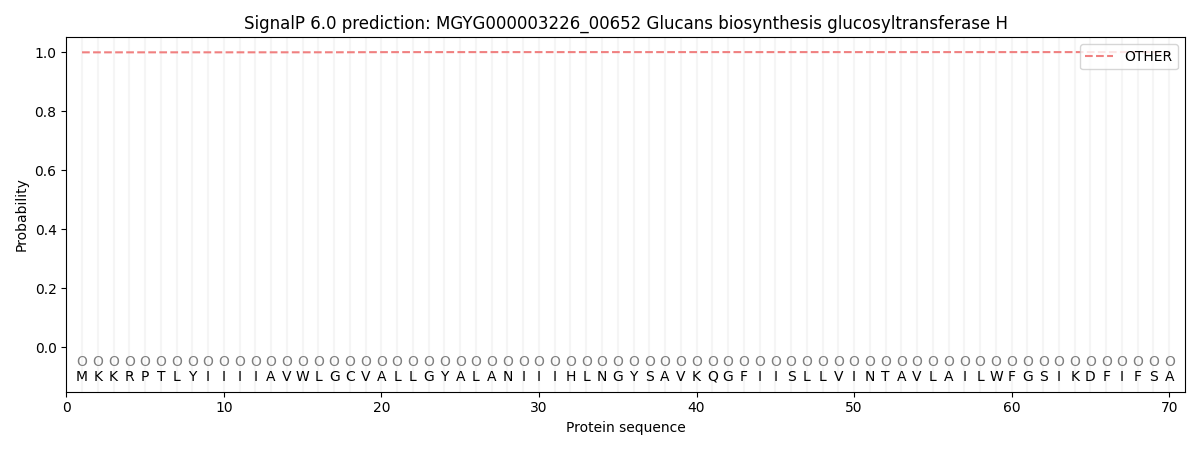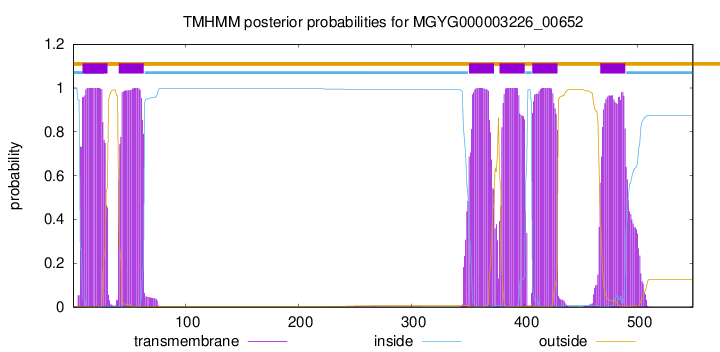You are browsing environment: HUMAN GUT
CAZyme Information: MGYG000003226_00652
You are here: Home > Sequence: MGYG000003226_00652
Basic Information |
Genomic context |
Full Sequence |
Enzyme annotations |
CAZy signature domains |
CDD domains |
CAZyme hits |
PDB hits |
Swiss-Prot hits |
SignalP and Lipop annotations |
TMHMM annotations
Basic Information help
| Species | QALS01 sp900552625 | |||||||||||
|---|---|---|---|---|---|---|---|---|---|---|---|---|
| Lineage | Bacteria; Firmicutes_A; Clostridia_A; Christensenellales; Borkfalkiaceae; QALS01; QALS01 sp900552625 | |||||||||||
| CAZyme ID | MGYG000003226_00652 | |||||||||||
| CAZy Family | GT2 | |||||||||||
| CAZyme Description | Glucans biosynthesis glucosyltransferase H | |||||||||||
| CAZyme Property |
|
|||||||||||
| Genome Property |
|
|||||||||||
| Gene Location | Start: 7770; End: 9419 Strand: - | |||||||||||
CAZyme Signature Domains help
| Family | Start | End | Evalue | family coverage |
|---|---|---|---|---|
| GT2 | 114 | 305 | 2e-24 | 0.8478260869565217 |
CDD Domains download full data without filtering help
| Cdd ID | Domain | E-Value | qStart | qEnd | sStart | sEnd | Domain Description |
|---|---|---|---|---|---|---|---|
| cd06421 | CESA_CelA_like | 7.29e-31 | 97 | 322 | 1 | 232 | CESA_CelA_like are involved in the elongation of the glucan chain of cellulose. Family of proteins related to Agrobacterium tumefaciens CelA and Gluconacetobacter xylinus BscA. These proteins are involved in the elongation of the glucan chain of cellulose, an aggregate of unbranched polymers of beta-1,4-linked glucose residues. They are putative catalytic subunit of cellulose synthase, which is a glycosyltransferase using UDP-glucose as the substrate. The catalytic subunit is an integral membrane protein with 6 transmembrane segments and it is postulated that the protein is anchored in the membrane at the N-terminal end. |
| COG1215 | BcsA | 1.06e-29 | 107 | 463 | 67 | 439 | Glycosyltransferase, catalytic subunit of cellulose synthase and poly-beta-1,6-N-acetylglucosamine synthase [Cell motility]. |
| cd06437 | CESA_CaSu_A2 | 6.88e-26 | 111 | 319 | 17 | 231 | Cellulose synthase catalytic subunit A2 (CESA2) is a catalytic subunit or a catalytic subunit substitute of the cellulose synthase complex. Cellulose synthase (CESA) catalyzes the polymerization reaction of cellulose using UDP-glucose as the substrate. Cellulose is an aggregate of unbranched polymers of beta-1,4-linked glucose residues, which is an abundant polysaccharide produced by plants and in varying degrees by several other organisms including algae, bacteria, fungi, and even some animals. Genomes from higher plants harbor multiple CESA genes. There are ten in Arabidopsis. At least three different CESA proteins are required to form a functional complex. In Arabidopsis, CESA1, 3 and 6 and CESA4, 7 and 8, are required for cellulose biosynthesis during primary and secondary cell wall formation. CESA2 is very closely related to CESA6 and is viewed as a prime substitute for CESA6. They functionally compensate each other. The cesa2 and cesa6 double mutant plants were significantly smaller, while the single mutant plants were almost normal. |
| cd06423 | CESA_like | 1.28e-19 | 111 | 276 | 13 | 180 | CESA_like is the cellulose synthase superfamily. The cellulose synthase (CESA) superfamily includes a wide variety of glycosyltransferase family 2 enzymes that share the common characteristic of catalyzing the elongation of polysaccharide chains. The members include cellulose synthase catalytic subunit, chitin synthase, glucan biosynthesis protein and other families of CESA-like proteins. Cellulose synthase catalyzes the polymerization reaction of cellulose, an aggregate of unbranched polymers of beta-1,4-linked glucose residues in plants, most algae, some bacteria and fungi, and even some animals. In bacteria, algae and lower eukaryotes, there is a second unrelated type of cellulose synthase (Type II), which produces acylated cellulose, a derivative of cellulose. Chitin synthase catalyzes the incorporation of GlcNAc from substrate UDP-GlcNAc into chitin, which is a linear homopolymer of beta-(1,4)-linked GlcNAc residues and Glucan Biosynthesis protein catalyzes the elongation of beta-1,2 polyglucose chains of Glucan. |
| pfam13641 | Glyco_tranf_2_3 | 1.52e-18 | 119 | 303 | 26 | 214 | Glycosyltransferase like family 2. Members of this family of prokaryotic proteins include putative glucosyltransferase, which are involved in bacterial capsule biosynthesis. |
CAZyme Hits help
| Hit ID | E-Value | Query Start | Query End | Hit Start | Hit End |
|---|---|---|---|---|---|
| QDL20008.1 | 3.56e-158 | 1 | 521 | 1 | 524 |
| QDL19322.1 | 3.56e-158 | 1 | 521 | 1 | 524 |
| QIN44161.1 | 3.56e-158 | 1 | 521 | 1 | 524 |
| QIN44840.1 | 3.56e-158 | 1 | 521 | 1 | 524 |
| QIN42784.1 | 3.56e-158 | 1 | 521 | 1 | 524 |
Swiss-Prot Hits download full data without filtering help
| Hit ID | E-Value | Query Start | Query End | Hit Start | Hit End | Description |
|---|---|---|---|---|---|---|
| Q9SRT3 | 5.07e-18 | 94 | 361 | 218 | 500 | Probable xyloglucan glycosyltransferase 6 OS=Arabidopsis thaliana OX=3702 GN=CSLC6 PE=1 SV=1 |
| Q9ZQB9 | 1.90e-15 | 129 | 361 | 277 | 520 | Probable xyloglucan glycosyltransferase 12 OS=Arabidopsis thaliana OX=3702 GN=CSLC12 PE=1 SV=1 |
| Q7PC69 | 1.42e-14 | 131 | 361 | 303 | 540 | Probable xyloglucan glycosyltransferase 3 OS=Oryza sativa subsp. japonica OX=39947 GN=CSLC3 PE=2 SV=1 |
| A5F1Q0 | 9.11e-13 | 113 | 344 | 154 | 402 | Glucans biosynthesis glucosyltransferase H OS=Vibrio cholerae serotype O1 (strain ATCC 39541 / Classical Ogawa 395 / O395) OX=345073 GN=opgH PE=3 SV=1 |
| Q9KSG9 | 9.11e-13 | 113 | 344 | 154 | 402 | Glucans biosynthesis glucosyltransferase H OS=Vibrio cholerae serotype O1 (strain ATCC 39315 / El Tor Inaba N16961) OX=243277 GN=opgH PE=3 SV=1 |
SignalP and Lipop Annotations help
This protein is predicted as OTHER

| Other | SP_Sec_SPI | LIPO_Sec_SPII | TAT_Tat_SPI | TATLIP_Sec_SPII | PILIN_Sec_SPIII |
|---|---|---|---|---|---|
| 0.999243 | 0.000033 | 0.000703 | 0.000000 | 0.000000 | 0.000020 |
TMHMM Annotations download full data without filtering help

| start | end |
|---|---|
| 9 | 31 |
| 41 | 63 |
| 351 | 373 |
| 378 | 400 |
| 407 | 429 |
| 467 | 489 |
